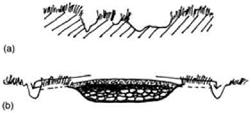This is the weakest soil of all, but is so extensive in many places that paths may be unavoidable, while wooden boardwalks are too expensive for long stretches. Experience with long-distance paths in Britain indicates that measures for crossing peat are needed at the outset for path use; otherwise, severely eroded surfaces will occur very quickly. There are several techniques for crossing peat, as follows.
|
Path construction in wetter soils: (a) The worn, rutted and muddy result of wear and tear without a path surface or drainage. (b) A path constructed by excavating the worn sections and laying the crushed stone on a layer of geotextiles. Drains alongside the path carry water away. |
Rafting
Round timber of around 100 mm (4 in.) diameter, in lengths to suit the required path width, is wired and stapled together side by side to form a continuous roll. This is laid out along the path after minimal preparation such as levelling hummocks, filling hollows and piping drains across the route. Surfacing material is then laid over the raft, which floats on the peat.




